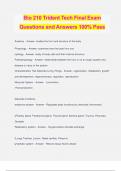Bio 210 Trident Tech Final Exam Questions and Answers 100% Pass Anatomy - Answer - studies the form and structure of the body Physiology - Answer - examines how the body func ons cytology - Answer - study of body cells and their internal structure Pathophysiology - Answer - relationship between the func on of an organ system and disease or injury to the system Characteristics That Describe Living Things - Answer - organization, metabolism, growth and development, responsiveness, regulation, reproduction Muscular System - Answer - -Locomotion -Heat production (Muscles,Tendons) endocrine system - Answer - -Regulates body functions by chemicals (hormones) (Pituitary gland, Parathyroid gland, Thyroid gland, Adrenal gland, Thymus, Pancreas, Gonads) Respiratory system - Answer - -Oxygen/carbon dioxide exchange (Lungs,Trachea, Larynx, Nasal cavities, Pharynx) lymphatic system - Answer - -Returns tissue fluid to blood -Defends against foreign organisms (Spleen, Lymph nodes, Thymus, Lymphatic vessels) integumentary system - Answer - -Barrier to invading organisms and chemicals -Temperature control (Skin, Hair, Subcutaneous tissue) nervous system - Answer - -Coordinates activities of other organ systems -Responds to sensations (Brain, Spinal cord, Nerves, Eyes, Ears) skeletal system - Answer - -Supports and moves body -Protects internal organs -Mineral storage -Blood formation (Bones, Cartilage, Ligaments, Bone marrow) cardiovascular system - Answer - -Transports oxygen and nutrients to tissues -Removes waste products (Heart, Blood, Blood vessels) reproductive system - Answer - -Produces germ cells (eggs and sperm) -Environment for growth of fetus (female) (Ovaries, Uterus, Mammary glands, Testes, Prostate gland, External genitalia) urinary system - Answer - -Elimination of wastes -Regulates pH and volume of blood (Kidneys,Urinary bladder,Urethra) digestive system - Answer - -Processes foods -Absorption of nutrients into body (Stomach, Intestinal tract, Liver, Pancreas, Esophagus Salivary gland) anatomic positon - Answer - Upright stance Feet parallel and flat on the floor Upper limbs at the sides of the body Palms face anteriorly (toward the front) Eyes look forward What body parts make up the axial and appendicular skeleton - Answer - The axial skeleton forms the central axis of the body and consists of the skull, vertebral column, and thoracic cage. The appendicular skeleton consists of the pectoral and pelvic girdles, the limb bones, and the bones of the hands and feet.




